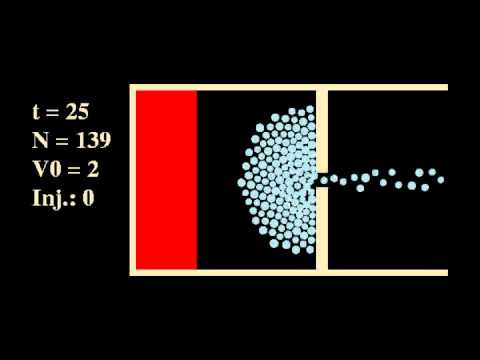Simulating dynamical features of pedestrian escape panic
This webpage provides supplementary information to the research article:
Dirk Helbing, Illés Farkas, and Tamás Vicsek:
Simulating dynamical features of escape panic
Nature 407, 487-490 (2000)
The information can be found also external pageherecall_made.
Abstract
One of the most disastrous forms of collective human behaviour is the kind of crowd stampede induced by panic, often leading to fatalities as people are crushed or trampled. Sometimes this behaviour is triggered in life-threatening situations such as fires in crowded buildings; at other times, stampedes can arise during the rush for seats or seemingly without cause. Although engineers are finding ways to alleviate the scale of such disasters, their frequency seems to be increasing with the number and size of mass events. But systematic studies of panic behaviour and quantitative theories capable of predicting such crowd dynamics are rare. Here we use a model of pedestrian behaviour to investigate the mechanisms of (and preconditions for) panic and jamming by uncoordinated motion in crowds. Our simulations suggest practical ways to prevent dangerous crowd pressures. Moreover, we find an optimal strategy for escape from a smoke-filled room, involving a mixture of individualistic behaviour and collective 'herding' instinct.
external pageRead more on the website of Naturecall_made
external pageFull text PDFcall_made
external pageNature News and Views PDFcall_made
external pageNature front cover PDFcall_made
in Hungarian external pageTeljes cikk PDFcall_made (Fizikai Szemle)
For non-profit users: Please request the simulation source code by

Videos and descriptions of disasters
external pageThis is a partial listcall_made of human stampedes. The following are some well-known disasters:
- 24.07.2010, Love Parade, Duisburg (Germany), external pageWikipediacall_made, external pageYouTubecall_made
- 15.04.1989, Hillsborough, Sheffield (UK), external pageWikipediacall_made, external pageYouTubecall_made
- 29.05.1985, Heysel stadium, Brussels (Belgium), external pageWikipediacall_made, external pageYouTubecall_made
- 02.01.1971, Ibrox (UK), external pageWikipediacall_made, external pageYouTubecall_made
Questions & Answers
1. Why is the model called social force model?
The "social force" is not a real physical force. It is an empirical mathematical tool that is applied to achieve the correct behavior. To put this into a broader physics perspective, experimental nuclear physics has many such empirical "form factors" and multipliers, which work well. Our 2000 paper combines this fictitious force with real physical forces (compression and friction), so we have real physical forces and non-real (non-physical) "forces" in the same equation. The accelerations computed from the steering "force" or the self-propeling "force" never actually occur physically. They are fictitious quantities used by the model. The only real physical quantity is the vectorial sum of forces, and this gives the acceleration of the particle (pedestrian) using F = m a.
2. How did you select the parameters of the model?
First of all, we tried to keep values realistic: τ = 0.1s or 0.5s eaction time, v0 = 1m/s or 5m/s preferred speed, m = 80kg pedestrian mass. Second, for the value of the force causing damage to the pedestrians (around 4kN) we looked into the engineering literature. Third, regarding the parameters A, B, k and κ of Eq.(2) in external pageHelbing et al (Nature 2000)call_made − and all other parameters as well − our model was an over-simplified model aiming to reproduce phenomena found in reality.
3. The model is continuous in space and time. What was the time step of the numerical integration?
The simulation code used for our paper in 2000 applied an adaptive time step size in the following way. The simulation uses three technical parameters: a default time step (DefaultDeltaT = 0.01), VelocChangeLimit = 0.01 and TimeStepMultiplier = 0.95. Before each simulation update the acceleration of each particle is computed and the time step is set to Δt = DefaultDeltaT. Next, the value of Δt is determined iteratively (with a "while" loop). As long as (i.e., while) the acceleration of any particle multiplied by the time step exceeds the parameter VelocChangeLimit, the time step is multiplied by TimeStepMultiplier. In other words, Δt is found by decreasing it in multiplicative steps of TimeStepMultiplier to the highest value fulfilling the "velocity change limit" condition. In summary, the applied integration method is a forward Euler integration with adaptive time step size.
4. What are the preferred directions in a room with one exit?
The preferred direction of a pedestrian (particle) is the direction of its self-propelling. In the case of the room with a single exit denote the diameter of a particle (pedestrian) by d. Connect the two end points of the exit and mark the two points that are within the doorway d/2 away from the door's two end points. At these two points draw two long lines (reaching inside the room) that are perpendicular to the line of the exit. If a particle (a disk) is entirely between these two long lines, then -- in the simulation code -- its preferred direction of motion points perpendicularly towards the line of the exit (i.e., parallel to the two long lines). If a particle is not entirely within the "central" stripe defined by these two long lines, but it does not touch the wall, then its preferred direction of motion will point toward a little inside the nearer doorpost such that one of the two lines parallel to this direction and touching the particle will pass through the point of the nearer doorpost. If a particle touches the wall, then its preferred direction of motion will be parallel to the wall and pointing toward the exit. Note that two-dimensional vectorial coordinates and geometry are used for the actual mathematical formulae that the program implements. Two further comments: (i) the original code uses "float" precision, but currently "double" is better and (ii) for numerical reasons d was often replaced by d + 10-5.
Contact us
Please click on our names to visit our homepages.
- Dirk Helbing
Professor at ETH Zürich
- external pageIllés Farkascall_made
Senior research assoc. at the Hungarian Academy
of Sciences and Eötvös University, Budapest
- external pageTamás Vicsekcall_made
Professor at Eötvös University, Budapest
Group leader at the Hungarian Academy of Sciences
